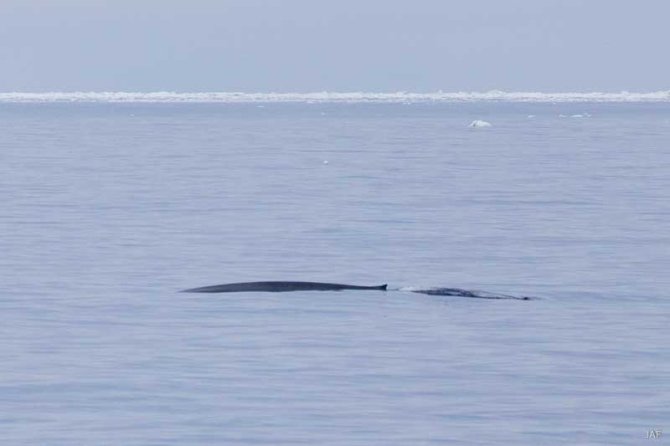
Blog: Researchers spotted whales during their way back north
The researchers on expedition to Antarctica return back North, because of a technical problem with one of Polarstern’s two propellers. Still there is room for research, such as ice fishing and counting birds, seals and whales.
Photo: After spotting his first ever Blue Whale, Bram finds it difficult to leave his observation post on the monkey deck.
We are on our way to the north, back to Cape Town. For the time being we are ‘single-legged’. Our faulty port-side propeller, fixed in forward position, will only be used once we make no further stops for our research.

Difficult first ice passage
We only left the polynia near Neumayer station on January 13. The open water along the Neumayer shelfice edge was getting smaller and smaller because persistent northeaster winds pressed the sea ice against us. A barrier of 30 to 40 miles of heavily packed sea ice separated us from more open ice areas further north. Normally, also such heavy ice would present no problem to Polarstern, but with one propeller it was a tough job. Two full days of breaking ice were needed. Each time crawling a little distance forward until stopped, then going back to create space to regain new speed and get a few meters further. Occasionally we were drifting faster with the southwestern currents than we made progress to the north.

Shadow to the horizon
But from 15 January onwards we reached less dense sea ice, where Polarstern could make reasonable progress also on a single propeller. That’s where we made plans for the remainder of our journey. There is some time left for research. In the loose ice and the outer ice edge, we have made three hauls with the nets. The counting of birds, seals and whales now is a full-time job, in which Bram and Jan make shifts and get only few hours of sleep. But the journey through the ice was again magic. Especially at night, with the low midnight sun it was fantastic, with Polarstern casting its shadow over the ice to the horizon.

Whales
The mirror-like surface of the water during those sunlit nights was only disturbed by playing groups of Minke Whales and even the giant among the whales, the Blue Whale. Bram rocketed sky-high, because that was his first Blue Whale sighting ever. Since then, Bram can hardly be chased out of the observation box even during his off-duty periods, because ‘you never know what comes next’. And rightfully so, because he has spotted several more Blue Whales. One would start to believe that there finally is a real recovery from the whaling days in the middle of the previous century. Blue Whales in the Southern Ocean were almost hunted to extinction. The original population of two- to three-hundred thousand had been decimated to probably under a thousand individuals.

Goodbye to the ice
With pain in our hearts we have had to say goodbye to the sea ice yesterday evening. Already for a day we sail through ice-free water. It immediately was a grey day, with a stormy winds increasing to 9 Beaufort. That’s not unusual in the Southern Ocean, but after a good month of quiet life in the sea ice, a rocking ship needs to get used to. The storm made our outside work impossible, but created some time for this fast blog. In two weeks it’s all done. We hope for a few more fishing attempts with our nets, and of course for good weather for continuation the bird and mammal surveys on the way home.
Jan Andries van Franeker, 18 January 2015
Southern Ocean 66°’46’ South – 00°11’ East
Air temperature -1°C
Jaeseu J9
This is highly informatics, crisp and clear.
ReactI think that everything has been described in systematic manner so that reader
could get maximum information and learn many things.
제이나인 마카오 카지노
제이나인 메이저 카지노 사이트
제이나인 안전 사설 토토 사이트
제이나인 안전 토토 사이트
제이나인 오래된 토토 사이트
https://www.j9korea.com